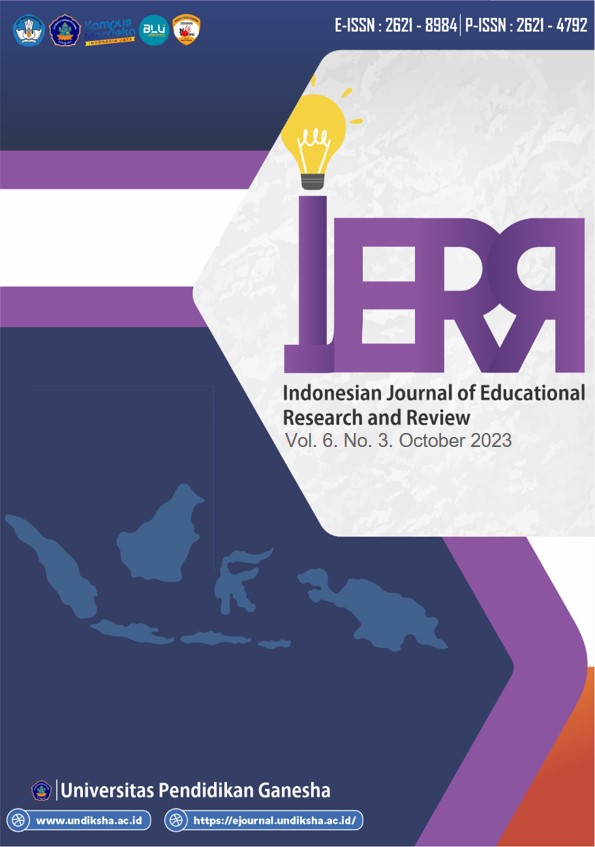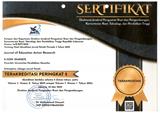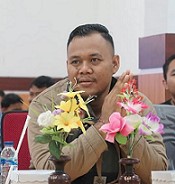How Important of Students' Literacy and Numeracy Skills in Facing 21st-Century Challenges: A Systematic Literature Review
DOI:
https://doi.org/10.23887/ijerr.v6i3.62206Keywords:
Literacy, Numeracy, 21st Century, Systematic Literature ReviewAbstract
Literacy Numeracy skills (LNS) are fundamental for facing global challenges in the 21st century. LNS can help people achieve their goals. However, there has not been a thorough study on literacy and numeracy research. To improve the quality of literacy and numeracy research, researchers must study much literature for further analysis. This research aims to analyze students' literacy and numeracy skills in facing 21st-century challenges. The research method used is the Systematic Literature Review to read 27 documents by searching for the keywords "literacy", "numeracy", and “Literacy and Numeracy”. This type of research is library research with the stages of determining research questions, searching literature, selecting articles, reading full papers, making abstractions, and conducting analysis. The data analysis technique used is content analysis. The study results show that the dominant research methodology used is quantitative; the instruments often used are tests and assessments. The chief field is mathematics; the overall educational level is junior high school and early childhood education. Some motivational results research related to literacy and numeracy skills includes digital competencies, learning videos, and games, effectively improving literacy and numeracy skills. Furthermore, not all learners have strong reading and numeracy abilities. A strong recommendation for further research is to develop learning media based on local wisdom using the Android platform. In addition, researchers must embed emergent literacy in the design and case study of didactically and pedagogically oriented research.
References
Adedoyin, O. O., & L.A., C. (2018). Predictors of numeracy skills giftedness in young children: Perceptions of Botswana early childhood practitioners. African Educational Research Journal, 6(4), 218–227. https://doi.org/10.30918/aerj.64.18.080.
Alvionita, D. M., Rahayu, W., & Hakim, L. El. (2022). The Influence Of Online Inquiry-Based Learning Model On Numeration Ability In View From Us Loc Of Control [In Bahasa]. AKSIOMA: Jurnal Program Studi Pendidikan Matematika, 11(3), 1775–1788. https://doi.org/10.24127/ajpm.v11i3.5492.
Anwar, M. (2021). Development of Foreign Language Teaching Material Based on Higher Order Thinking Skills ( HOTS ) to Increase Student s ’ Literacy Skills. Jurnal Eralingua, 5(2), 565–578. https://doi.org/10.26858/eralingua.v5i2.26863.
Arono, Arsyad, S., Syahriman, Nadrah, & Villia, A. S. (2022). Exploring the effect of digital literacy skill and learning style of students on their meta-cognitive strategies in listening. International Journal of Instruction, 15(1), 527–546. https://doi.org/10.29333/iji.2022.15130a.
Aunio, P., Mononen, R., Ragpot, L., & Törmänen, M. (2016). Early numeracy performance of South African school beginners. South African Journal of Childhood Education, 6(1), 8. https://doi.org/10.4102/sajce.v6i1.496.
Cahyani, D., Inggrid, Nulhakim, L., & Yuliana, R. (2021). Pengembangan Media Pembelajaran Scrapbook Dongeng Fabel Terhadap Minat Literasi siswa SD. MIMBAR PGSD Undiksha, 9(2), 337. https://doi.org/10.23887/jjpgsd.v9i2.35271.
Carpenter, R. E., Coyne, L., Silberman, D., & Takemoto, J. K. (2022). Enhanced numeracy skills following team-based learning in United States pharmacy students: a longitudinal cohort study. Journal of Educational Evaluation for Health Professions, 19(29), 29. https://doi.org/10.3352/jeehp.2022.19.29.
Chalkiadaki, A. (2018). A systematic literature review of 21st century skills and competencies in primary education. International Journal of Instruction, 11(3), 1–16. https://doi.org/10.12973/iji.2018.1131a.
Chan, J. Y., & Scalise, N. R. (2022). Numeracy skills mediate the relation between executive function and mathematics achievement in early childhood. Cognitive Development, 62(January), 101154. https://doi.org/10.1016/j.cogdev.2022.101154.
Deda, Y. N., Nasruddin, N., Bagus, I., Pascima, N., Liunokas, A. B., Ndandara, A., & Supardi, R. (2023). Development of Android-Based Learning Media in Indonesia : A Systematic Literature Review. 6(2), 110–117. https://doi.org/10.18421/SAR62.
Dore, R. A., Logan, J., Lin, T. J., Purtell, K. M., & Justice, L. (2020). Characteristics of Children’s Media Use and Gains in Language and Literacy Skills. Frontiers in Psychology, 11, 1–22. https://doi.org/10.3389/fpsyg.2020.02224.
Geiger, V. (2018). Generating Ideas for Numeracy Tasks across the Curriculum. Proceedings of the 41st Annual Conference of the Mathematics Education Research Group of Australasia, July, 314–321. https://eric.ed.gov/?id=ED592434.
Geiger, V. (2016). Teachers as Designers of Effective Numeracy Tasks. In White, B., Chinnappan, M. & Trenholm, S. (Eds.). Opening up Mathematics Education Research (Proceedings of the 39th Annual Conference of the Mathematics Education Research Group of Australasia), 2013, 254–261. https://eric.ed.gov/?id=ED572390.
Genlott, A. A., & Grönlund, Å. (2013). Improving literacy skills through learning reading by writing: The iWTR method presented and tested. Computers and Education, 67, 98–104. https://doi.org/10.1016/j.compedu.2013.03.007.
Hudson, K. N., Ballou, H. M., & Willoughby, M. T. (2021). Short report: Improving motor competence skills in early childhood has corollary benefits for executive function and numeracy skills. Developmental Science, 24(4), 1–9. https://doi.org/10.1111/desc.13071.
Irving, K. E. (2006). The impact of technology on the 21st century. Teaching Science in the 21st Century, March 1981, 3–19. https://cmapsconverted.ihmc.us/rid=1JVHR9TKT-1VMCFZP-SHW/21st century.pdf.
Iswara, H. S., Ahmadi, F., & Ary, D. Da. (2022). Numeracy Literacy Skills of Elementary School Students through Ethnomathematics-Based Problem Solving. Interdisciplinary Social Studies, 2(2), 1604–1616. https://doi.org/10.55324/iss.v2i2.316.
Johar, R., Wahyuna, A., & Maidiyah, E. (2022). Development of Numeracy Problems with the Context of Herbal Medicines in Junior High School. Jurnal Didaktik Matematika, 4185, 280–297. https://doi.org/10.24815/jdm.v9i2.27783.
Juhaevah, F. (2022). Developing mathematics problems using local wisdom context of Maluku to improve students’ numeracy. Jurnal Elemen, 8(1), 323–339. https://doi.org/10.29408/jel.v8i1.4524.
Kalogiannakis, M., Papadakis, S., & Zourmpakis, A. I. (2021). Gamification in science education. A systematic review of the literature. Education Sciences, 11(1), 1–36. https://doi.org/10.3390/educsci11010022.
Kernagaran, V., & Abdullah, A. (2022). A Systematic Literature Review of Flipped Learning in English as Second Language (ESL) Context. International Journal of Instruction, 15(2), 793–814. https://doi.org/10.29333/iji.2022.15243a.
Kesumadewi, D. A., Agung, A. A. G., & Rati, N. W. (2020). Model Pembelajaran CIRC Berbantuan Media Cerita Bergambar Meningkatkan Hasil Belajar Bahasa Indonesia Siswa SD. MIMBAR PGSD Undiksha, 8(2), 303–314. https://doi.org/10.23887/jjpgsd.v8i2.25524.
Khofifah, S., & Ramadan, Z. H. (2021). Literacy conditions of reading, writing and calculating for elementary school students. Journal of Educational Research and Evaluation, 5(3), 342–349. https://doi.org/10.23887/jere.v5i3.37429.
Kim, Y. G., Petscher, Y., & Vorstius, C. (2020). The Relations of Online Reading Processes ( Eye Movements ) with Working Memory , Emergent Literacy Skills , and Reading Proficiency The Relations of Online Reading Processes ( Eye Movements ) with. Scientific Studies of Reading, 00(00), 1–19. https://doi.org/10.1080/10888438.2020.1791129.
Lubaale, Y. A. M., Nakabugo, G., & Nassereka, F. (2021). Learning outcome in literacy and numeracy in Uganda: Mining Uwezo assessment data to demonstrate the importance of maternal education. IASSIST Quarterly, 45(3–4), 1–15. https://doi.org/10.29173/iq1001.
Miftah, R. N., & Setyaningsih, R. (2022). Development of LKPD Based on Minimum Competency Assessment (AKM) on geometry material to Improve Numeral Literacy skills [In Bahasa]. AKSIOMA: Jurnal Program Studi Pendidikan Matematika, 11(3), 2199–2208. https://pdfs.semanticscholar.org/270a/5c262f9b600f93c7b1bfb87d7193cf3dd00e.pdf.
Monteleone, C., White, P., & Geiger, V. (2018). Defining the Characteristics of Critical Mathematical Thinking. Annual Meeting of the Mathematics Education Research Group of Australasia, July, 559–566. https://ojs.lib.buu.ac.th/index.php/education2/article/view/7040.
Musliman, R., Rahayah, S., & Din, R. (2013). Assessing Students ’ Spatial Intelligence for Literacy and Numeracy Skills. Procedia - Social and Behavioral Sciences, 90(InCULT 2012), 695–701. https://doi.org/10.1016/j.sbspro.2013.07.142.
Oktafiani, D., Nulhakim, L., & Alamsyah, T. P. (2020). Pengembangan Media Pembelajaran IPA Berbasis Multimedia Interaktif Menggunakan Adobe Flash Pada Kelas IV. Mimbar PGSD Undiksha, 8(3), 527–540. https://doi.org/10.23887/jjpgsd.v8i3.29261.
Özkür, F. (2020). Analyzing Motor Development and Emergent Literacy Skills of Preschool Children. International Education Studies, 13(4), 94. https://doi.org/10.5539/ies.v13n4p94.
Prihandoko, L. A. (2021). The Interplay between Digital Competencies and Information Literacy in Academic Writing Online Class during COVID-19 Pandemic (PLS-SEM Approach). Eralingua: Jurnal Pendidikan Bahasa Asing Dan Sastra, 5(1), 234. https://doi.org/10.26858/eralingua.v5i1.18843.
Purnomo, H., Sa’dijah, C., Hidayanto, E., Sisworo, S., Permadi, H., & Anwar, L. (2022). Development of instrument numeracy skills test of minimum competency assessment (MCA) in Indonesia. International Journal of Instruction, 15(3), 635–648. https://doi.org/10.29333/iji.2022.15335a.
Putri, M. A. K., Pambudi, D. S., & Kurniati, D. (2022). Development Of Using Cultural Value Lesson Study-Based Learning Devices For Learning Community To Improve Numeration [In Bahasa]. AKSIOMA: Jurnal Program Studi Pendidikan Matematika, 11(4), 2567. https://doi.org/10.24127/ajpm.v11i4.6164.
R, J. R., & Ratnasari. (2022). Student Numerical Literacy in Solving Quadrilateral and Trapezoidal Problems [In Bahasa]. AKSIOMA: Jurnal Program Studi Pendidikan Matematika, 11(3), 2533–2544. https://doi.org/10.24127/ajpm.v11i3.5714.
Rezky, M., Hidayanto, E., & Parta, I. N. (2022). Students’ Numerical Literacy Ability in Solving Socio-Cultural Context Questions on the Topic of Geometry at the Junior High School Level [In Bahasa]. AKSIOMA: Jurnal Program Studi Pendidikan Matematika, 11(2), 1548. https://doi.org/10.24127/ajpm.v11i2.4879.
Rohmah, A. N., Sutama, S., Hidayati, Y. M., Fauziati, E., & Rahmawati, L. E. (2022). Planning for Cultivation Numerical Literacy in Mathematics Learning for Minimum Competency Assessment (AKM) in Elementary Schools. Mimbar Sekolah Dasar, 9(3), 503–516. https://doi.org/10.53400/mimbar-sd.v9i3.51774.
Salma, A. (2019). Analisis Gerakan Literasi Sekolah Terhadap Minat Baca Siswa Siswa Sekolah Dasar. Mimbar PGSD Undiksha, 7(2), 1–10. https://doi.org/10.23887/jjpgsd.v7i2.17555.
Singh, P., Hoon, T. S., Md Nasir, A., Md Ramly, A., Md Rasid, S., & Meng, C. C. (2021). Card game as a pedagogical tool for numeracy skills development. International Journal of Evaluation and Research in Education, 10(2), 693–705. https://doi.org/10.11591/ijere.v10i2.20722.
Sulo, T., Kendagor, R., Kosgei, D., Tuitoek, D., & Chelangat, S. (2012). Factors affecting research productivity in public universities of Kenya: The case of Moi University, Eldoret. Journal of Emerging Trends in Economics and Management Sciences, 3(5), 475–484. https://journals.co.za/doi/abs/10.10520/EJC127672.
Suprapto, N., Sunarti, T., Suliyanah, Wulandari, D., Hidayaatullaah, H. N., Adam, A. S., & Mubarok, H. (2020). A systematic review of photovoice as participatory action research strategies. International Journal of Evaluation and Research in Education, 9(3), 675–683. https://doi.org/10.11591/ijere.v9i3.20581.
Tegeh, I. M., Astawan, I. G., Sudiana, I. K., & Kristiantari, M. G. R. (2021). Murder Learning Model Assisted By Metacognitive Scaffolding To Improve Students’ Scientific Literacy and Numeracy Skills Through Science Studies in Elementary Schools. Jurnal Pendidikan IPA Indonesia, 10(4), 618–626. https://doi.org/10.15294/jpii.v10i4.32926.
Urwick, J. (2022). Dimensions of inequality in children’s literacy and numeracy in Uganda: Evidence from a household-based assessment. International Journal of Educational Development, 88. https://doi.org/10.1016/j.ijedudev.2021.102525.
Winarni, S., Kumalasari, A., Marlina, M., & Rohati, R. (2021). The Effectiveness of Mathematics Learning Videos to Support Students’ Numerical and Digital Literacy Skills [In Bahasa]. AKSIOMA: Jurnal Program Studi Pendidikan Matematika, 10(2), 574. https://doi.org/10.24127/ajpm.v10i2.3345.
Zafar, M. W., Shahbaz, M., Sinha, A., Sengupta, T., & Qin, Q. (2020). How renewable energy consumption contribute to environmental quality? The role of education in OECD countries. Journal of Cleaner Production, 268, 122149. https://doi.org/10.1016/j.jclepro.2020.122149.
Downloads
Published
How to Cite
Issue
Section
License
Copyright (c) 2023 Yohanis Ndapa Deda, Hermina Disnawati, Otaget Daniel

This work is licensed under a Creative Commons Attribution-ShareAlike 4.0 International License.
Authors who publish with the Indonesian Journal of Educational Research and Review (IJERR) agree to the following terms:
- Authors retain copyright and grant the journal the right of first publication with the work simultaneously licensed under a Creative Commons Attribution License (CC BY-SA 4.0) that allows others to share the work with an acknowledgment of the work's authorship and initial publication in this journal.
- Authors are able to enter into separate, additional contractual arrangements for the non-exclusive distribution of the journal's published version of the work (e.g., post it to an institutional repository or publish it in a book), with an acknowledgment of its initial publication in this journal.
- Authors are permitted and encouraged to post their work online (e.g., in institutional repositories or on their website) prior to and during the submission process, as it can lead to productive exchanges, as well as earlier and greater citation of published work. (See The Effect of Open Access)












